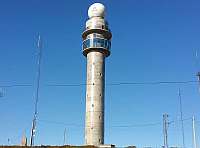Dual polarization technology in IPMA radar products
 2016-01-05 (IPMA)
2016-01-05 (IPMA)
In October 2015 IPMA started the operation of the Arouca/Pico Gralheiro (A/PG) radar system, in dual polarization mode. This came to be reflected on further processing of various data stream of polarimetric type, given the normally obtained by conventional systems.
These quantities allow, through a relatively complex processing chain, to identify and distinguish the nature of different signal types detected by the radar. Based on this discrimination it is possible to filter, amongst the set of detected targets, those targets which are undisired from a meteorological point of view.
This filtering allows, e.g., to obtain rainfall observations without the influence of undesirable targets which, in the absence of this filtering, would contaminate the obtained field, thus generating a number of pixels wrongly assigned to precipitation.
Among those targets that are of interest to consider for measuring precipitation, one has to consider hidrometeors such as raindrops, snow crystals and hailstones, among others.
Among those targets that are uninteresting to consider for precipitation measurement purposes and that, therefore, it is of importance to filter out, one has to consider insects. It is also important to remove from observations the sea clutter echoes (resulting from slight radar beam incidence on the sea surface, under normal propagation conditions), the anomalous propagation echoes (resulting from strong radar beam incidence on the sea surface, under anomalous propagation conditions), the echoes originating on RLAN/WLAN systems interference (equipments designed to enable wireless access to the internet) and, finnaly, the wind farm echoes.
In Figure 1, an example of a rainfall observation performed by the radar without any filtering, is presented. It is an A/PG radar observation, 16/12/2015, 13:15 UTC, exhibiting many undesirable signals. To illustrate the potential for improving the quality of precipitation products, a series of observations are displayed in an animation (see figure 2); these series of observations were alternately performed with and without the participation of the filtering tool. The observations concern the period 13:15 - 14:15 UTC of that day. It is quite outstanding to see the obtained results by applying the filtering tool. This will have a positive impact on several IPMA radar products quality, considering the A/PG system alone.

